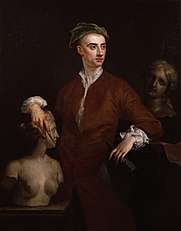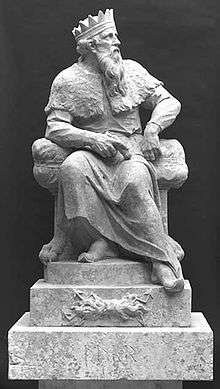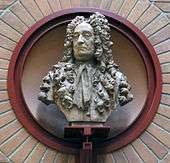John Michael Rysbrack
Johannes Michel or John Michael Rysbrack, original name Jan Michiel Rijsbrack[1] (24 June 1694[2] – 8 January 1770), was an 18th-century Flemish sculptor, who spent most of his career in England. His birth-year is sometimes (wrongly) given as 1693 or 1684.

Family background and early life
Rysbrack was born on 24 June 1694 in Antwerp, the son of the landscape painter Pieter Rijsbraeck. His older brother Pieter Andreas Rijsbrack was a landscape and still life painter; and a younger brother Gerard Rijsbrack was a still life and sports painter. He studied drawings by Italian masters, before settling in London in 1720.
Career
In London, Rysbrack quickly established himself as the leading sculptor, a position he was to retain until the mid-1740s, remaining one of the top three sculptors in Britain until shortly before his death. He produced vivid portraits and monuments of lively baroque composition, rapidly establishing himself as a highly sought-after sculptor. He executed busts and funerary monuments of many of the most prominent men of his day, including the monument to Isaac Newton in Westminster Abbey, a statue of Marlborough, and busts of Walpole, Bolingbroke, and Pope. Dr Cox Macro commissioned him to make a bust of Flemish painter Peter Tillemans on his death in 1734.[3]
In 1733 he carved a magnificent marble portrait bust of George Hamilton, 1st Earl of Orkney (1666–1737) in the guise of a Roman centurion. Orkney was a distinguished general serving under the Duke of Marlborough. Orkney had taken the surrender of the French at the Battle of Blenheim in 1704, and he took part in numerous subsequent battles during the War of the Spanish Succession. One of Rysbrack's greatest works, the bust of Lord Orkney is on display at the Victoria and Albert Museum, London. Its special character owes something to a bond between the sculptor and Lord Orkney, one that had its origins nearly 30 years earlier and was no doubt enhanced in their conversation when Lord Orkney sat to the sculptor for the modelling of the bust. Rysbrack would have been aware of Lord Orkney’s heroism during the various campaigns in the Low Countries during the War of the Spanish Succession, not least the Battle of Ramillies on 23 May 1706 after which Orkney led the pursuit of the defeated French forces. Following the battle and pursuit, city after city – including Brussels, Bruges and Antwerp – capitulated to Marlborough's forces. In Antwerp, Rysbrack’s home city, to which Orkney was dispatched by Marlborough with re-enforcements for Major-General Cadogan, the Spanish Governor was in no mood to offer even a token resistance, and constrained the French part of the garrison to join him in surrendering the city on 6 June. The arrival in Antwerp of Marlborough’s victorious forces, led by Orkney (Marlborough himself arriving on 12 June) is an event that Rysbrack, then a boy aged 12, would surely have witnessed. These events must have given sculptor and Lord Orkney a great deal of opportunity for shared reminiscences during the sittings for the bust.[4]
In St Michael and All Angels Church, Badminton, there is another splendid monument by Rysbrack, signed and dated 1754. The 2nd and the 3rd Duke of Beaufort are depicted in Roman costume, one standing, the other seated on the sarcophagus and holding a medallion. Decorative, asymmetrical drapery hangs down over the sarcophagus.[5]
Rysbrack also cast the bronze equestrian statue of William III in Queen Square, Bristol in 1733, and sculpted a later monument to Edward Colston in All Saints' Church, Bristol.
Death
Rysbrack died in Vere Street, Westminster, in 1770 [6] and is buried in St Marylebone Parish Church. [7]
Gallery of work
 Self Portrait, acquired by the Heritage Fund of the King Baudouin Foundation, at the KMSKA
Self Portrait, acquired by the Heritage Fund of the King Baudouin Foundation, at the KMSKA
 King William III, Queen Square, Bristol
King William III, Queen Square, Bristol Inigo Jones, Chiswick House, London
Inigo Jones, Chiswick House, London.jpg) Bacchus, Gulbenkian Museum
Bacchus, Gulbenkian Museum Hans Sloane, British Library, London
Hans Sloane, British Library, London
- Tomb monument for Sir Watkin Williams-Wynn, Ruabon, Denbighshire, erected 1755
 Bust of Inigo Jones, 1725
Bust of Inigo Jones, 1725.jpg) Bust of a man believed to be Peter Tillemans, 1727, Yale Center for British Art
Bust of a man believed to be Peter Tillemans, 1727, Yale Center for British Art
References
- Rysbrack, John Michael: Biography. Accessed 12 July 2010.
- Eustace, Katharine. "Rysbrack, (John) Michael [formerly Johannes Michiel]", Oxford Dictionary of National Biography, 21 May 2009. Accessed 21 October 2018.
- Noakes, Aubrey, Sportsmen in a Landscape (Ayer Publishing, 1971, ISBN 0-8369-2005-8), pp. 47–56: Peter Tillemans and Early Newmarket, Google Books. Accessed 7 February 2009.
- D. Wilson, ‘The British Augustan oligarchy in portraiture: Michael Rysbrack and his bust of the Earl of Orkney’, The British Art Journal, Volume XI, No. 2 [2011], pp.43-61; and see D. Wilson,‘A Very early Portrait by Michael Rysbrack: the Earl of Macclesfield’, The Georgian Group Journal, Vol. XVII [2009], pp. 19-40.
- St. Michael and All Angels, Great Badminton (webpage), 19 July 2013
- Peter Cunningham (1850). Hand-book of London: past and present. John Murray. p. 521.
- "Marylebone Pages 242-279 The Environs of London: Volume 3, County of Middlesex. Originally published by T Cadell and W Davies, London, 1795". British History Online. Retrieved 20 July 2020.
External links
| Wikimedia Commons has media related to John Michael Rysbrack. |
- Portraits of Rysbrack
- "Model for the tomb of Sir Isaac Newton". Victoria and Albert Museum. Retrieved 19 November 2007.
- John Michael Rysbrack at Find a Grave